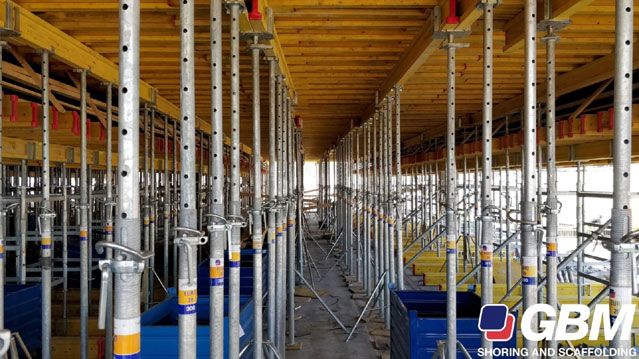DIN EN 1065 GBM props: manufactured in compliance with the world's toughest standard.
GBM's heavy duty props are certified in compliance with the DIN EN 1065 standard, which defines one of the toughest standards in the construction industry. Discover what the "quality" of a prop actually means.
In this page:
- The UNI EN 1065 standard,
- When was the UNI EN 1065 standard actually written? By who?,
- Why are DIN EN 1065 props divided into classes? And what are the implications behind belonging to one class as compared to another?,
- Which elements does the DIN EN 1065 standard define?,
- Which specifications are laid down regarding materials?,
- Which specifications are laid down regarding configuration of props?,
- Which other specifications are provided?

The UNI EN 1065 standard
GBM's heavy duty props are manufactured in compliance with the requirements laid down by the DIN EN 1065 standard, with a certificate awarded by the German university institute (https://www.tum.de/) just like the world's most prestigious companies in the industry, PERI and DOKA.
But what does this actually mean?
When was the UNI EN 1065 standard written? And by who?
The UNI EN 1065 European standard was approved by the CEN on 10 June 1998, and came into force from 1999.
The CEN, an acronym standing for “Comitato Europeo di Normazione” in Italian (European Committee for Standardisation in English, Comité Européen de Normalisation in French, Europäische Komitee für Normung in German) drafted this standard in three official versions, in English, French and German. Translations into other languages used in Europe carried out under the responsibility of a CEN member and notified to the Central Office, have the same status as the original official versions.
CEN members are the national standardisation bodies of the following countries:
Austria, Belgium, Denmark, Finland, France, Germany, Greece, Ireland, Island, Italy, Luxembourg, Norway, Holland, Portugal, United Kingdom, Czech Republic, Spain, Sweden and Switzerland.
Why are DIN EN 1065 props divided into classes? And what are the implications behind belonging to one class as compared to another?
The standard per se provides for classifying into different classes.
Prospectus 2 of the standard lays down the classification of the prop into classes or models, depending on length at maximum extension (at 50 cm intervals between one model and the other, for example between D35 and D40) and the nominal characteristic resistance.
Classes A, B and C props must comply with the nominal characteristic resistance values required for the respective maximum extensions; classes D and E props instead apply a nominal characteristic resistance to any possible extension length thereof.
Which elements does the DIN EN 1065 standard define?
The standard outlines the typical definition of a prop and its components.
More in detail, it defines:
- Adjustable telescopic steel prop;
- Terminal sideboard;
- Fork head;
- Threaded ring nut;
- Inner pipe;
- Outer pipe;
- Length adjustment device;
- Pin;
- Length at maximum extension;
- Main principles regarding units of measurement and names.
Which specifications are laid down regarding materials?
The standard indicates which types of steel can be used as source materials (for example type FU steel obtained from de-oxidation is not allowed), it addresses impurities and defects as well as corrosion protection measures.
Partly referring to other pre-existent European standards on materials, bars, pipes and casting, the EN 1065 standard establishes:
- Any limits to changes carried out during cold processing (such as shear yield strength);
- The five finish degrees, from F1 to F5, of the single components of the prop, including minimum protection measures against corrosion, in particular minimum thicknesses in microns, as concerns hot-dip galvanisation.
Which specifications are laid down regarding configuration of props?
The standard provides for defining the configurations of the following elements that the props are made up of, alongside the processes implemented for their manufacture:
- Pipes, with the conformity definition of the cross-sections of the pipes in compliance with the pre-existent EN and ISO standards, minimum thicknesses of the pipes and how the holes are drilled;
- Welding, to be carried out in compliance with the EN 729-2 standard;
- Length adjustment device, with definitions and adjustments regarding threading, ring nuts, pins and the relative nominal minimum diameters;
- Permanent device against inadvertent slipping off;
- Sizes, shapes (divided into five classes from A to E) and the materials the sideboards are made of;
- Dimensions and configurations of the fork heads in the fixed fork head props;
- Hand protection anti-shearing system;
- Minimum extended length and distance between the prop in the fully open and fully closed configurations thereof (not less than 1.00 m)
- An at least 300 mm overlapping length between the inner pipe and the outer pipe when the prop is fully open;
- Data provided by the manufacturer regarding the props.
- Class of the prop;
- The relative standard (EN 1065);
- The code identifying the name or trademark of the prop's manufacturer (G as regards GBM);
- Year of manufacture of the prop (the last two figures).
Which other specifications are provided?
The standard also outlines the steps of the prop verification process, specifying the technical data of the properties of the components the prop is made up of, as well as the verification methods with the aim of meeting minimum requirements. Specifications regarding theoretical verifications and test methods regarding physical features of the props are also laid down.
The last paragraph also lays down specifications regarding marking, which must be stamped, or provided in relief, or provided on a steel plate fixed to the prop; the marking must indicate:
News

BAUMA 2025 - 7-13 APRIL 2025

GBM's shipbuilding scaffoldings

Props required to sustain a slab: guidelines on how to establish distances, classes and quantities.
GBM Contacts: info, prices & quotes
Would you like further information on GBM products? Ask anything!
 Italiano
Italiano English
English Deutsch
Deutsch Français
Français Português
Português Polski
Polski Български
Български Română
Română Español
Español Русский
Русский Српски
Српски Hrvatski
Hrvatski Slovenski
Slovenski Shqip
Shqip Magyar
Magyar English (US)
English (US)